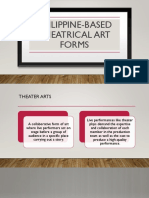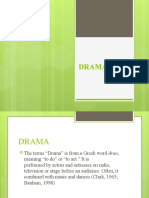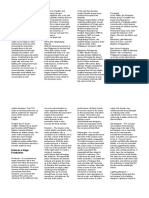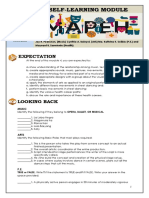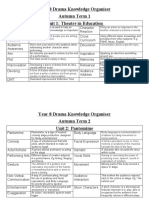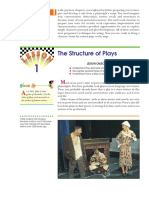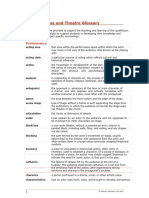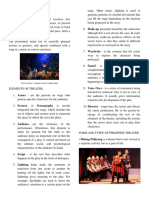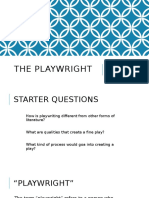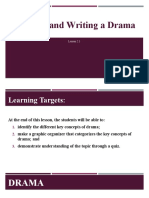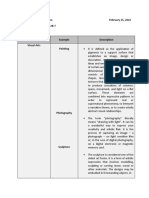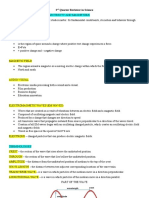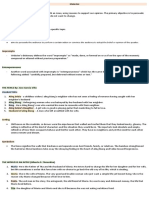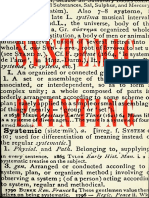MAPEH Quarter 4 Reviewer
MAPEH Quarter 4 Reviewer
Uploaded by
cali annaCopyright:
Available Formats
MAPEH Quarter 4 Reviewer
MAPEH Quarter 4 Reviewer
Uploaded by
cali annaOriginal Description:
Copyright
Available Formats
Share this document
Did you find this document useful?
Is this content inappropriate?
Copyright:
Available Formats
MAPEH Quarter 4 Reviewer
MAPEH Quarter 4 Reviewer
Uploaded by
cali annaCopyright:
Available Formats
MAPEH
ART,MUSIC?
THEATRICAL FORMS
Tragedy Drama
It is a dramatic play portraying the struggle of a It is a play that is "for real". The characters represent
strong- willed protagonist against fate, as predestined realistic and everyday people.
by mysterious, divine, social, or psychological forces,
culminating in disaster and usually caused by a flaw in
the protagonist's character.
Melodrama
Comedy
It is a dramatic composition characterized by
it is a dramatic play of light and humorous character, extravagant theatricality and the dominance of plot
typically with a cheerful and happy ending and physical action over characterization
The Elements of Arts as Applied to an Original Performance
1) Sound and Music. 3) Costume, Mask, Makeup, and Accessories
These set for the audience different moods and These comprise the visual effects, of which the main
emotions. Through the use of different sounds, they function is to enhance visibility and aesthetic value.
provide different effects to the play that heighten the They help make the character appear realistic
emotions of the characters and the audience. according to the role he/she portrayed.
2) Gesture, Movement, and Dance. 4) Spectacle
These are bodily movements or actions that usually This is something exhibited for view as something
express emotions, character, and narrative actions unusual, notable, or entertaining, especially an eye-
with accompanying sound or music. Every single catching dramatic public display may be regarded
gesture, movement or dance step conveys a meaning impressive and breathtaking and on stage if visual,
or message. lighting, sound, music, costumes, dance, and special
effects are properly manifested in a play.
Examples of Philippine Plays
Sarswela Moro Moro
It is a type of melodrama in three acts where pieces are It depicts the conflicts between the Moros and the
both spoken and sung. It was also employed as a tool to Christians. Themes like love, and vengeance, and religion.
fight against colonization.
Senakulo
Epic Poetry
It is also known as Passion play. This dramatization of the
Dating back to the pre-colonial period and commonly life and death of Jesus Christ has been a part of the lives
presented during festivals and gatherings, it is considered of the Catholics and is celebrated during Holy Week.
by scholars to be the highest point of Filipino folk
literature. The usual topics are romance and adventure.
Traditional Folkdance
It is one of the oldest forms of theater and these are
Duplo dances that reflect the lives of the people in a certain
place or region and describe their culture and origin.
It is a poetic debate presented through song and dance
originating from indigenous courtship customs. In this
type of play, poets use proverbs and riddles to present
their suit to the woman of their choice. Bodabil
It is Vaudeville of American origin that became uniquely
Filipino with the localization of the name, Bodabil. It is a
variety show consisting of musical numbers and comedic
and dramatic skits with songs and dances. It was popularized by Filipino artists like Dolphy.
Role of a Character as an Actor/Performer, or Production staff
PRODUCER
One of the main roles of a producer is to oversee the LIGHTING DESIGNER
overall aspects of the production. He or she is responsible
uses colored lights or filters, as well as special effects such
to the financial and managerial functions of the
as increasing or lowering the bright- ness of light, creating
production. He/she provides financial backing to the
flickering effects, and synchs them to create the mood
production or invites investors to pour in financing, and
and atmosphere. The lighting designer plans all these and
hires the creative staffs like the director, writers,
adds detailed notes on the script for the lighting crew to
choreographer, and composer. Though the casting of
follow during rehearsals and the actual performance.
actors is a job for the director, a producer has the power
of casting approval. And acts like a bridge to connect
financing or business in the realization of the playwright's
vision. However, in school setting, the teacher, or the COSTUME DESIGNER
school itself acts as the producer. The task of a costume designer is to create the actors'
costumes or outfits that are suitable to their characters.
The costume designer looks into the time and setting of
DIRECTOR the script to make the look of the characters more
believable. He or she also takes consideration the
provides the overall vision and guidance of a
personality of each character to achieve authenticity in
performance, ensuring that all elements are unified, and
the delivery of script. The costumes maybe sewn, hand-
that production runs smoothly. And works closely with
made, or assembled to create the characters' depiction in
the design and production teams and sometimes with the
the script.
playwright to hone the vision and define the production
schedule. Ensures that all elements are executed perfectly
and that everyone in the production are in tune with
his/her artistic vision to create a great impact in the SOUND DESIGNER
audience. The director guides and instructs the actors in is responsible in incorporating sound effects to create the
all the phases of rehearsals. right balance of sound, the tempo, and overall effect of
the production.
PLAYWRIGHT
develops the concepts and puts them into script plays. TECHNICAL DIRECTOR
The script forms the basis of the entire production. It They oversee all the instructions relating to lighting and
contains the narrative through dialogues, and it may also sounds. During the technical rehearsals, the technical
have the description of settings, sounds, mood, lights, director notes all the cues, errors, and other issues to iron
costumes, and makeup of the characters. them out before the actual production.
PRODUCTION MANAGER STAGE MANAGER
His/her tasked is overseeing the crews for the sets and oversees all the director's instructions from costumes to
props, the sound and music, the lighting, and the make up, and from set to the actors and actresses. Also,
costumes. He or she manages the behind-the-scenes of the stage manager notes all the director's instructions in
the production. his/her script so that in the absence of the director,
he/she can supervise the rehearsals. He/she also checks
the attendance and punctuality of the actors.
SET DESIGNER
supervises the construction of the set (or sets) that will be
the physical world of the play's characters. The set and set CHOREOGRAPHER
pieces may be realistic, but it can be done in other styles is responsible with the dance steps that are suitable for
such as minimalism or whimsical. The set designer may the dance numbers of the production. In case there are
use a variety of materials like backdrops, theater flats, fight scenes, he or she will choreograph the scenes in
curtains/drapes, or LED screens. The set designer must accordance with the director's vision and ensure safety
work with the director to note the flow of action to create for the actors and actresses.
a suitable ground plan for the actors to move around in
MAKEUP DESIGNER
works closely with the costume designer to achieve a
suitable look. The makeup designer makes the actors look
real and believable based on their emotions, age,
personality as well as the time and place of the events of
the play. In some cases, a makeup designer may use PE
prosthetics, wigs, masks, and other accessories to alter
and suit the character's role.
CHEER DANCE
Is coined from the words cheer and dance. This is to cheer Rooted from cheerleading and dominated by gymnastic
and shout out words or while performing. This is a physical skills such as jumps, tumbling skills, lifts a toss combined
activity where one expresses emotions or gestures while with shouting of cheers and yells to lead the crowd to cheer
performing bodily movement usually in time with rhythm. for a certain team during a game or sport.
BASIC HAND MOVEMENTS IN CHEER DANCE
BEGINNING STANCE LOW TOUCHDOWN
Feet together, hands down by the side in Arms extended straight down and
blades parallel to each other, fist facing in
CHEER STANCE BOW AND ARROW
Feet more than shoulder width apart, One arm extended to side with other
hands down by the side in blades arm bent at elbow in a half “T” motion
CLASP OVERHEAD CLASP
Hands clasped, at the chin, elbows in Arms are straight, above the head in a
clasp and slightly in front of the face
CLAP TABLETOP
Hands in blades, at the chin, elbows in Arms bent at elbow, fists in front of
shoulders
HIGH V LOW CLASP
Arms extended up forming a “V”, relax Arms extended straight down, in a
clasp and slightly in front of the body
LOW V PUNCH
Arms extended down forming a “V” One arm extended straight up, one arm on hip, in
a fist
TOUCHDOWN L MOTION
Arms extended straight and parallel to One arm extended to the side with
each other, fist facing in other arm extended in a punch
motion, (Left L shown)
DIAGONAL HALF T
One arm extended in a high “V” and Both arms parallel to the ground and
the other arm extended in a low “V” bent at the elbows, fists into shoulders
(Right Diagonal shown)
T MOTION SIDE LUNGE
Both arms extended straightLead
outleg
tobent with the knee over the ankle,
the side
and parallel to the ground,back
relaxleg
thestraight, feet perpendicular to each
shoulders
other
FRONT LUNGE
HEALTH
PERSONAL HEALTH CAREER PLAN
Step 1. Self-Assessment.
This is the first step in knowing the health career that suits you.
This step requires an honest evaluation of yourself. It is necessary for you to know yourself. You need to understand your
capabilities and shortcomings.
Components: your strengths, weaknesses, interests, hobbies, personal experiences, family income, skills, and competencies.
Step 2. Career Exploration.
Exploring health career options through different ways or methods is an essential step to choosing a particular health career
path to take.
You can do this through reading articles, browsing the net, attending fora, and meetings.
This stage is about knowing where to look and what to look for. It refers to searching different careers and work
environments that suit you.
This step includes: listing down of health career options, conducting informational interview, job shadowing (on-the-job
learning), job temping (short term job), attending internship, and volunteering.
Step 3. Decision Making.
Once you have assessed yourself and explored the health career that you are interested to pursue, you are now ready to
make decisions.
In this step, you need to consider both current and future goals in life by narrowing down your choices.
This step includes listing of pros and cons, comparing your personal strengths and interests, choosing a specific health career
to pursue, considering suggestion of family, and finally deciding a health career to take.
Step 4. Plan of Action.
Now that you have chosen a health career, you are now ready to make a career plan. At this point, you will design your action
plan or identify and organize the necessary steps to achieve your desired goals.
This step includes designing a plan to reach health career goals, identifying short-term and long-term goals, identifying
education and training requirements, developing job search strategies, and creating road map considering possible problems
that may arise along the way.
PERSONAL HEALTH CAREER PLAN OF GERALD AS A FUTURE NURSE
Step 1 Step 3
Self-Assessment Decision Making
Evaluates abilities, the financial capabilities of his To become an Operating Room Nurse.
family, future tasks, assignments, among others.
Step 4
Step 2
Plan of Action
Career Exploration
To gather information on how to enroll in this course
Searches the internet about the environment and
including the school that offers the specific course
work conditions of being a nurse.
You might also like
- 2nd Quarter Reviewer in MAPEH 10Document6 pages2nd Quarter Reviewer in MAPEH 10cali anna92% (12)
- 3rd Quarter Reviewer in Mapeh 10Document8 pages3rd Quarter Reviewer in Mapeh 10cali anna80% (5)
- Tokyo - A New Avant Garde - MoMA PDFDocument47 pagesTokyo - A New Avant Garde - MoMA PDFDiego Mauro100% (1)
- PilarsDocument6 pagesPilarsXev Matthew Dela CruzNoch keine Bewertungen
- HahaDocument3 pagesHahaJoan Marie Ocon86% (14)
- Types of CharacterDocument22 pagesTypes of CharacterANGELIE CRISTINE POMADONoch keine Bewertungen
- Arts ModuleDocument4 pagesArts ModuleRegie BugtongNoch keine Bewertungen
- Arts 10 - Quarter 4 - Module 1 - Theater Arts Themes and Elements of Art Applied To Performance.9ppDocument9 pagesArts 10 - Quarter 4 - Module 1 - Theater Arts Themes and Elements of Art Applied To Performance.9ppDioscora Efondo90% (10)
- Theatre Arts JSS 3Document36 pagesTheatre Arts JSS 3jezreelamachree74Noch keine Bewertungen
- Drama FictionDocument6 pagesDrama Fictionleansalvador8Noch keine Bewertungen
- Week011 Theatre and DramaDocument10 pagesWeek011 Theatre and DramaNoe AgubangNoch keine Bewertungen
- Grade 10 - Drama AppreciationDocument19 pagesGrade 10 - Drama AppreciationladyNoch keine Bewertungen
- Philippine Based Theatrical Art FormsDocument37 pagesPhilippine Based Theatrical Art FormsLovely Shaine MalaluanNoch keine Bewertungen
- Performing Arts - TheatreDocument15 pagesPerforming Arts - TheatreDJ Free MusicNoch keine Bewertungen
- Creative WritingDocument16 pagesCreative Writingtanegaann23Noch keine Bewertungen
- Contemporary Philippine Arts From The Region Week 5Document54 pagesContemporary Philippine Arts From The Region Week 5KAYZELLE REFAMONTENoch keine Bewertungen
- Las Q4 Mapeh 10 Arts - 100338Document6 pagesLas Q4 Mapeh 10 Arts - 100338monerabacanaNoch keine Bewertungen
- DLMCH - Humanities Book - Chapter 5Document32 pagesDLMCH - Humanities Book - Chapter 5mikaela thereseNoch keine Bewertungen
- Arts 10 4th QuarterDocument37 pagesArts 10 4th QuarterSamantha DelaraNoch keine Bewertungen
- Ajol File Journals - 456 - Articles - 89130 - Submission - Proof - 89130 5413 222569 1 10 20130527Document8 pagesAjol File Journals - 456 - Articles - 89130 - Submission - Proof - 89130 5413 222569 1 10 20130527Ibrahim Abdulrazaq YahayaNoch keine Bewertungen
- Group 3 - PresentationDocument38 pagesGroup 3 - PresentationJhoanne ValdezNoch keine Bewertungen
- ReviewerDocument4 pagesReviewerPressyJ RespicioNoch keine Bewertungen
- The History of DramaDocument42 pagesThe History of DramaConie PanchoNoch keine Bewertungen
- q4 Arts Mapeh Las Week 2Document4 pagesq4 Arts Mapeh Las Week 2Ronel NebraoNoch keine Bewertungen
- FINAL ARTS 10 Quarter 4Document35 pagesFINAL ARTS 10 Quarter 4Crislyn BañadosNoch keine Bewertungen
- DramaDocument30 pagesDramaEdelyn AgadNoch keine Bewertungen
- Introduction To DramaDocument9 pagesIntroduction To DramaKristine BucuNoch keine Bewertungen
- DramaDocument22 pagesDramaYatoNoch keine Bewertungen
- Mapeh 10 Arts Theatre PlayDocument5 pagesMapeh 10 Arts Theatre PlayChlouisse Kielle FavisNoch keine Bewertungen
- Secondary Arts 10 Q4 Module1Document19 pagesSecondary Arts 10 Q4 Module1Danilo CentenoNoch keine Bewertungen
- Performing Arts Media: Theatre VocabularyDocument6 pagesPerforming Arts Media: Theatre VocabularyusagibrianNoch keine Bewertungen
- Bataan, Joy Jesica G.-SS123Document4 pagesBataan, Joy Jesica G.-SS123bataan.joyjesicaNoch keine Bewertungen
- MapehDocument3 pagesMapehJocebel Freyra AbadNoch keine Bewertungen
- Drama and Theatre TermsDocument21 pagesDrama and Theatre TermsGulalai JanNoch keine Bewertungen
- Self-Learning Module: ExpectationDocument8 pagesSelf-Learning Module: ExpectationJohn Andy AbarcaNoch keine Bewertungen
- MAPEH 10 Q4 Week 4Document8 pagesMAPEH 10 Q4 Week 4John Andy Abarca0% (1)
- Group 3 PresentationDocument77 pagesGroup 3 PresentationJerraldCliff RamirezNoch keine Bewertungen
- Year 8 Drama Knowledge Organiser 2Document4 pagesYear 8 Drama Knowledge Organiser 2Bee Bee TanNoch keine Bewertungen
- DRAMADocument4 pagesDRAMAjoyce ayudaNoch keine Bewertungen
- ArtApp Module 3a (FN)Document4 pagesArtApp Module 3a (FN)Brent Neil SobrepeñaNoch keine Bewertungen
- Structure of The PlayDocument5 pagesStructure of The PlayHarurot UyyNoch keine Bewertungen
- 5.1 StructureDocument5 pages5.1 StructureHarurot UyyNoch keine Bewertungen
- Arts and Pe ReviewerDocument2 pagesArts and Pe ReviewerSHYRA MARIE ALFONSONoch keine Bewertungen
- A Level Drama and Theatre GlossaryDocument19 pagesA Level Drama and Theatre Glossarydani3llaxo10Noch keine Bewertungen
- Grade 10 Iv Quarter ArtsDocument32 pagesGrade 10 Iv Quarter ArtsMarcky Bayta100% (1)
- Q4 Cpar L1Document7 pagesQ4 Cpar L1PressyJ RespicioNoch keine Bewertungen
- Romuel Christian EnriquezDocument2 pagesRomuel Christian EnriquezJenny StypayNoch keine Bewertungen
- MAPEHDocument7 pagesMAPEHJystreem KazutoNoch keine Bewertungen
- Cpar ReviewerDocument3 pagesCpar ReviewerPressyJ RespicioNoch keine Bewertungen
- Music (Musical Play)Document13 pagesMusic (Musical Play)Glaiza MabantaNoch keine Bewertungen
- Theater - Humanities 2Document3 pagesTheater - Humanities 2Norjehanie Ali ParamataNoch keine Bewertungen
- Secondary Arts 10 Q4 Module2Document11 pagesSecondary Arts 10 Q4 Module2Danilo CentenoNoch keine Bewertungen
- Ch. 13 - The Playwright - TaggedDocument16 pagesCh. 13 - The Playwright - TaggedJames M.Noch keine Bewertungen
- Reading and Writing A DramaDocument21 pagesReading and Writing A DramaPaulo RodriguezNoch keine Bewertungen
- Ma. Clarince Manuba - Art AppreciationDocument15 pagesMa. Clarince Manuba - Art AppreciationMaria Clarince ManubaNoch keine Bewertungen
- Drama-Its Elements An Overview: ThemeDocument4 pagesDrama-Its Elements An Overview: ThemeRozi Khan100% (1)
- 5cwdrama Humss12Document12 pages5cwdrama Humss12Haibrelly SatarNoch keine Bewertungen
- Role of Stage Production Grade 10 DiscussionDocument54 pagesRole of Stage Production Grade 10 DiscussionEsguerra, Franchesca Margaux A.Noch keine Bewertungen
- Theater: Supply The Empty Circles With Words That Characterize/describe The Word: TheaterDocument10 pagesTheater: Supply The Empty Circles With Words That Characterize/describe The Word: TheaterJun Greg MaboloNoch keine Bewertungen
- Manila Tytana Colleges: College of Arts and Sciences Humanities DepartmentDocument3 pagesManila Tytana Colleges: College of Arts and Sciences Humanities DepartmentArlene DacpanoNoch keine Bewertungen
- Conventions of DramaDocument8 pagesConventions of DramaMonyet unguNoch keine Bewertungen
- Name: Anna Daniella S. Luna February 25, 2022 Year & Section: BSCESEP-T-2B-TDocument9 pagesName: Anna Daniella S. Luna February 25, 2022 Year & Section: BSCESEP-T-2B-TAnna Daniella LunaNoch keine Bewertungen
- Break a Leg!: An Actor's Guide to Theatrical Practices, Phrases, and SuperstitionsFrom EverandBreak a Leg!: An Actor's Guide to Theatrical Practices, Phrases, and SuperstitionsNoch keine Bewertungen
- 3rd Quarter Reviewer in Science 10Document9 pages3rd Quarter Reviewer in Science 10cali anna100% (1)
- Science Quarter 4 ReviewerDocument8 pagesScience Quarter 4 Reviewercali anna75% (4)
- 3rd Quarter Reviewer in Science 10Document9 pages3rd Quarter Reviewer in Science 10cali anna100% (1)
- 2nd Quarter Reviewer in ScienceDocument3 pages2nd Quarter Reviewer in Sciencecali annaNoch keine Bewertungen
- 2nd Quarter Reviewer in EnglishDocument7 pages2nd Quarter Reviewer in Englishcali annaNoch keine Bewertungen
- 3rd Quarter Reviewer in English 10Document3 pages3rd Quarter Reviewer in English 10cali annaNoch keine Bewertungen
- A Guide in Practical Research 1Document3 pagesA Guide in Practical Research 1cali annaNoch keine Bewertungen
- 2nd Grading Reviewer in IctDocument4 pages2nd Grading Reviewer in Ictcali annaNoch keine Bewertungen
- Teacher Resume 2010Document2 pagesTeacher Resume 2010trenttNoch keine Bewertungen
- Lesson Coverage For English For Academic and Professional PurposesDocument4 pagesLesson Coverage For English For Academic and Professional PurposesIsrael CeneciroNoch keine Bewertungen
- Introduction To Barnstone StudiosDocument2 pagesIntroduction To Barnstone StudiosScribdBlueNoch keine Bewertungen
- Business Essentials Canadian 8th Edition Ebert Test Bank 1Document76 pagesBusiness Essentials Canadian 8th Edition Ebert Test Bank 1david100% (43)
- Cesare Brandi 001Document8 pagesCesare Brandi 001Mateo Neira100% (1)
- Embodied Existential - ArchitectureDocument16 pagesEmbodied Existential - ArchitectureAdriana OspinaNoch keine Bewertungen
- TextileSurfaceDesign PDFDocument82 pagesTextileSurfaceDesign PDFZhohana RodriguezNoch keine Bewertungen
- 3q Mapeh 7 DLP SampleDocument56 pages3q Mapeh 7 DLP SampleMaria isabel DicoNoch keine Bewertungen
- LCS PPT Structure and EssayDocument13 pagesLCS PPT Structure and EssayYanHongNoch keine Bewertungen
- GE015 Teaching Arts Activity 2 LATONERODocument2 pagesGE015 Teaching Arts Activity 2 LATONEROAbigail T. GamalNoch keine Bewertungen
- DANCE - ARTS 1100 Module 2Document19 pagesDANCE - ARTS 1100 Module 2fiona abenojaNoch keine Bewertungen
- Old-Art-Programme-Marginalia 03 2018Document3 pagesOld-Art-Programme-Marginalia 03 2018Бенеамин СимеоновNoch keine Bewertungen
- MUX 118 Syllabus 2011Document6 pagesMUX 118 Syllabus 2011Busi MhlongoNoch keine Bewertungen
- Dadaism. Surrealism, and The Unconscious: AbstractDocument12 pagesDadaism. Surrealism, and The Unconscious: AbstractΕιρήνη ΕιρηνοπούλουNoch keine Bewertungen
- Precis Writings LET BEDocument20 pagesPrecis Writings LET BEMuhammad Naseem Ishaq /ME Lab Engineer100% (1)
- The Heidelberg ProjectDocument6 pagesThe Heidelberg Projectapi-339264830Noch keine Bewertungen
- Art Appreciation Module 7 Martinez Romnick Mel S.Document14 pagesArt Appreciation Module 7 Martinez Romnick Mel S.Kimmy MaklasNoch keine Bewertungen
- Architecture and Modernity A CritiqueDocument278 pagesArchitecture and Modernity A Critiquealecz_doro100% (13)
- Bow ArtsDocument2 pagesBow ArtsJulius BayagaNoch keine Bewertungen
- Pop Art EssayDocument4 pagesPop Art Essayapi-496239023Noch keine Bewertungen
- Basic Philosophical Perspectives of ArtDocument5 pagesBasic Philosophical Perspectives of ArtAron LazaNoch keine Bewertungen
- Art Appreciation Prelim ActivityDocument16 pagesArt Appreciation Prelim ActivityLaarnie Garcia Torreon IINoch keine Bewertungen
- 2009 ロイヤルカレッジ個展Document200 pages2009 ロイヤルカレッジ個展Yoshitomo Morioka100% (1)
- Leland Ryken Christian Guides To The ClassicsDocument25 pagesLeland Ryken Christian Guides To The ClassicsGuilherme FerreiraNoch keine Bewertungen
- Systemic Painting PDFDocument72 pagesSystemic Painting PDFPa To N'Co50% (2)
- Sheung WanDocument7 pagesSheung Wanapi-283844563Noch keine Bewertungen
- DLL Mapeh 7 - Tmdi - Elements of ArtsDocument2 pagesDLL Mapeh 7 - Tmdi - Elements of ArtsCris Ann Pausanos100% (1)
- Lost in Translation - Linguistics, Cross-Disciplinary and Beyond - Asia Research NewsDocument3 pagesLost in Translation - Linguistics, Cross-Disciplinary and Beyond - Asia Research Newslynn.qijudyNoch keine Bewertungen
- IPG Fall 2014 Art TitlesDocument126 pagesIPG Fall 2014 Art TitlesIndependent Publishers GroupNoch keine Bewertungen












